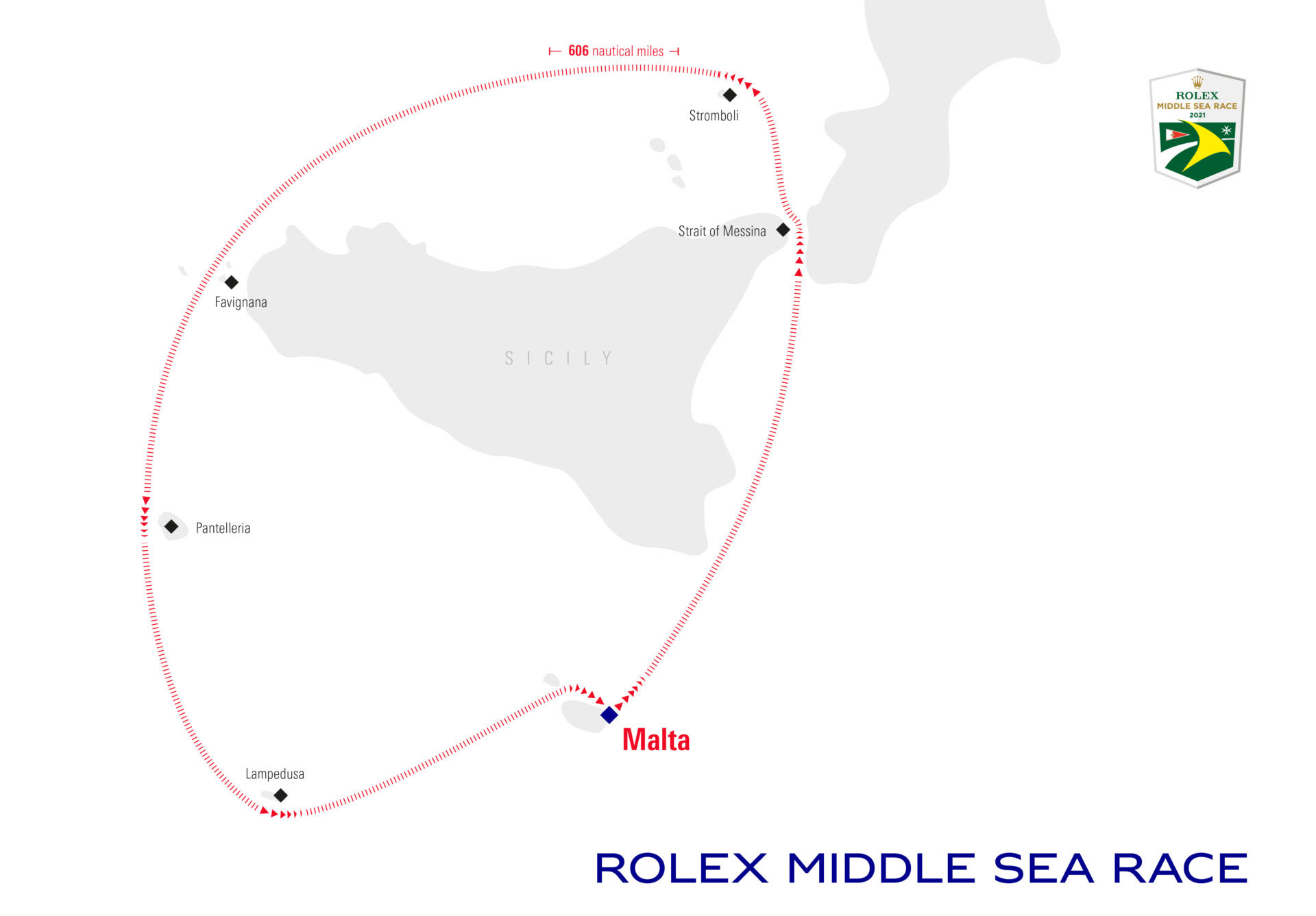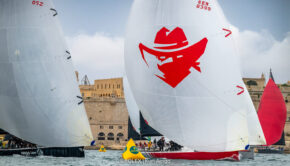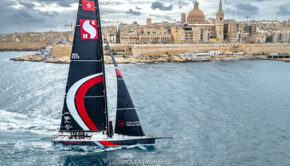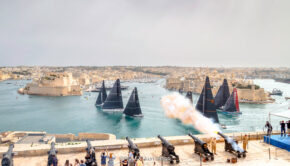David vs Goliath in Middle Sea Race
Published on October 26th, 2023
Andrea Recordati’s Wally 93 Bullitt (ITA) claimed class and overall victory in the 2023 Rolex Middle Sea Race. The 44th edition of the 606 nm course around Sicily had 110 yachts representing 26 nations start on October 21 from Malta, with Bullitt finishing in 02d 14:39:14.
Bullitt finished behind the Farr 30m Leopard (MON) which claimed monohull line honors, while they narrowly nipped for overall honors the wife and husband team of Christina and Justin Wolfe that double-handed their Sun Fast 3300 Red Ruby (USA).
The Sun Fast 3300 came close to one of the biggest ever upsets in offshore yachting as by first light on October 25, Red Ruby appeared stuck in orbit of Lampedusa, 110 nautical miles from the finish. From what looked, onshore at least, a wholly unpromising position, determination, belief and skill drove the American boat to within 24 seconds of a sensational overall win on time correction.
“When I came into the Rolex Middle Sea Race my dream was to win class,” Recordati said. “That would have been a fantastic result against boats more adapted to this type of offshore race. Coming first overall in corrected time, honestly … I am ecstatic, almost speechless. I am super happy for the boat, she deserves it. I am especially happy for my crew. I have an exceptional team and they really deserve this too.”
Recordati enjoyed the early boat for boat rivalry with Leopard, even if he lost out in the end: “The duel was like déjà vu from last year. If they had got stuck with the others in Messina, we might have got them on the water. They just managed to pull through and did a fabulous race, so it’s good for them. I never came into this race thinking we would have a chance to do line honours and it is nice to be second in elapsed time.”
Bullitt’s 20 person crew was a who’s who from the America’s Cup, round the world racing and maxi yacht scene:
Andrea Recordati, Bozidar Matkovic, Guillermo Altadill, Joca Signorini, Luigi Filippo Orsi Magngelli Alvera, Luke Molloy, Maciej Malag, Marc Lagesse, Martin Strömberg, Mate Ivic, Matthew Joubert, Michael Pammenter, Miguel Jauregui, Peter Van Niekierk, Phil Jameson, Richard Bouzaid, Richard Fryer, Tai Vinnie, and Vinicio Vanossi.
Bullitt Navigator Lagesse offered a run through of the key moments on the course:
“Before the race, in consultation with our weather router Marcel Van Triest, our early strategy was to get north as quickly as possible. When the breeze built to over 20 knots with a big sea state, we loosely abandoned our strategy of getting north and looked for flat water and less wind to preserve the boat. This decision worked because when we got into the Strait of Messina, we were ahead.
“We hugged the mainland coast of Italy to get out of the current. During the passage we crossed in front and behind Leopard, it was so close. Half way up the strait, Lucky (Juan K 27m) was in front of us. It looked as though they tacked into the current and they lost out, so we hitched back into the beach. Both us and Leopard went all the way in; you could have thrown a tennis ball to the beach and at one point we even had a knot of counter current.
“At the Villa San Giovanni ferry terminal, we made the decision to swap over to the Sicilian side as the current was two knots less. We popped out of Messina in first place, which was surprising. Lucky was still stuck in the current and we put four miles on them. Leopard just got through about a mile and a half behind us.
“Leopard got some land breeze and rolled us, but we got them back as we picked up the wind again, and we were neck and neck all the way to Stromboli, where Leopard crossed our bow by just a boat length.
“After Stromboli our strategy was to go on the wind. We expected it to ease and then come through from the south. So going north meant that when that happened, we could still lay Palermo and not get stuck in there. Leopard was covering us from the front on every tack, which I always take as a compliment.
“At one point, we did tack against the shift as an insurance policy and went north to cover Lucky and Pyewacket (Volvo Open 70). In the main, though, we kept to our strategy of staying on the wind. It worked.
“After passing Palermo we were expecting to park up, but the southerly connected quickly so there was not much of a slowdown in boat speed. However, by then we were losing to Leopard because that was their favorable angle. The sea state after Favignana got up, but as we were slightly cracked off the breeze it wasn’t too bad; nothing like the first night.
“The leg to Pantelleria was straight forward, with no surprises but some geographical shifts around the island so we took a few hitches in there. Leopard was by then about eight miles ahead of us, but we knew we were in the game on corrected time. Approaching Lampedusa, we knew we were going to be lifted, which would make it difficult to lay, so we put in a couple of security hitches. At Lampedusa we were 20 miles behind Leopard, but had them on corrected, so our strategy was just to put all the crew on the rail and send it.
“Comparisons to last year’s race against Leopard are difficult, because Leopard is a very different boat this year. For sure, we sailed better, Bullitt has a great crew, and they kept the performance solid. For us, the goal was to have a good race, so a class win would have been great. The overall win is the cherry on the top. I think it’s full marks for Bullitt.”
As for the overall runner-up, the double-handed victory remains an impressive achievement for the Wolfes who reside in the Pacific Northwest of the United States.
“We have been racing double-handed together for 28 years,” explains Christina. “We actually met to do a local double-handed race in 1995 and we’ve been together ever since!”
The success of the partnership is based on having similar strengths allowing the pair to switch roles frequently while racing with no concerns. “We very much prefer double-handed racing because of the challenge. Plus, we enjoy sailing with each other,” she continued. “To be successful it is important to know your teammate’s abilities and trust them.”
The pair clearly have an extraordinary relationship on both land and water. “One of the things we can do, because we have been sailing together so long, is make decisions really quickly,’ they explain. “There is no board meeting to decide if we are going to tack or gybe. We both see the same information, we both come to the same conclusion because, essentially, we have developed as sailors together.”
Turning to the race, it was not clearcut that Red Ruby would be contesting honors in class let alone overall. “So much happened in that race,” the pair continue. “You are constantly changing, the conditions change, the course changes, you are constantly going by something that you have to be careful about, it is just non-stop. We went hours and hours and hours at a time without any rest at all, because there was too much going on.”
From the get-go, Red Ruby was up against it, but never once gave up. At the start, the wind changed direction and then disappeared, leaving their start stuck on the line and forcing the Race Committee to postpone the next start. In the mêlée that followed, Red Ruby’s headsail pre-feeder jammed. An issue that took most of the leg to Messina to resolve. Little by little they got themselves into a groove, and realized they were in the game.
“We try hard and do not do anything by half. We came here to race a great race and put everything out there. We knew from the middle of the first day that we were going well. We are proud about what we did. This is known for being a really tough race and we had conditions that none of the weather models predicted.
“We made some great navigational calls; we made a lot of miles one night at the western end of Sicily staying off the shoreline and away from a wind hole. That move got us to a point where we could make the distance on our opposition. Things like that over the course of long race add up, sometimes it is meters but sometimes they turn into miles.”
While the weather models between Lampedusa and Malta suggested Red Ruby had no hope to beat Bullitt, the Wolfes were untroubled. They had wind as none of the models had got the forecast completely right all race. However, it really was not until they were approaching Malta that the Red Ruby team appreciated that they were within touching distance of victory.
“When we got within cell phone reception west of Malta, we knew it was going to be super close. We were ripping, so there really wasn’t anything else to do. We were already at maximum. What we didn’t know was what was going to happen once we came through the South Comino Channel and turned. Was it going to get light, was it going to be windier, would we be able to fly a spinnaker? Frankly, we had hours to think about it, what would we do, how would we do it.”
The problems seem never-ending and exhausting. Even the final dash to the finish was pressured. “We could not see the fairway buoy. We knew where it was on the chart, but we still nearly ran into it. Then we had a ferry coming in at 30 knots that we had to avoid.”
In the end, Red Ruby fell agonizingly short. “Over the course of a 600 mile race, how many places did you leave 24 seconds. All over the place. One better tack, one better call on the current in the Messina Strait. We don’t even know what happened on the west coast of Stromboli. Even the start did not go so well. How many thousands of seconds did it take us to cross the line?”
Impressively, the pair were able to see the result with some perspective.
“The Rolex Middle Sea Race was on our bucket list. This was a once in a lifetime opportunity to be here. It is like nothing we have ever done before and has certainly lived up to the hype and surpassed our hope. The challenge of the race and the beauty of the race is definitely unique. It is not like just going out and sailing a race, it has its own aspects that are appealing, and it has to be one of the best in the world.”
Red Ruby’s adventure has given the boat a firm place in the pantheon of legends surrounding the Rolex Middle Sea Race. If the Wolfes need encouragement to repeat the journey, there is a lesson from history that might help. In the 2015 race, Mascalzone Latino lost out by nine seconds in the contest for the Rolex Middle Sea Race trophy. The following year, 2016, the Italian yacht returned and won.
Event information – Results – Facebook
Source: RMYC










 We’ll keep your information safe.
We’ll keep your information safe.